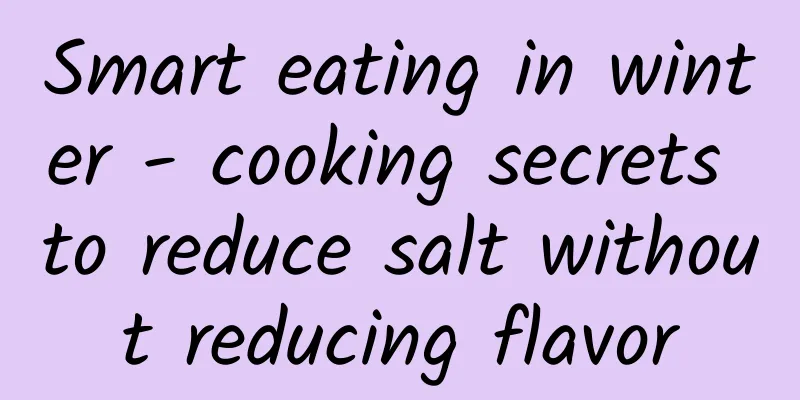Smart eating in winter - cooking secrets to reduce salt without reducing flavor

|
The salt intake in the diet of Chinese residents is generally high. In the past 40 years, the average daily salt intake of Chinese adults has been more than 10 grams, which is twice the amount recommended by the World Health Organization. The average daily salt intake of residents in southern my country is 10-12 grams, while that of residents in northern China is as high as 15-22 grams. [1] Excessive salt intake increases the risk of high blood pressure. Surveys have found that people who consume 12 grams or more of salt per day have a 14% higher risk of developing high blood pressure, and this risk also increases with increasing salt intake. [2] So where does the salt we eat come from? Many people may wonder why their salt intake exceeds the standard when they don’t usually use much salt when cooking? Today, let's first use a picture to talk about the main sources of our salt intake: In order to ensure the taste and flavor of food and ensure its shelf life, many food industries also add a lot of hidden salt. For example, the condiments we often eat, such as soy sauce, contain 17 grams of salt per 100 grams, and chicken essence contains 2 grams of salt per 15 grams. Snacks such as biscuits also contain 4 grams of salt per 100 grams, and the salt content of plums per 100 grams exceeds 18 grams! Here you can also evaluate your usual salt intake to see if it exceeds the 5 grams recommended by the World Health Organization? Excessive intake of salt hidden in food will increase the burden on the kidneys, cause edema, and hair loss, and will also increase the incidence of cardiovascular and cerebrovascular diseases such as hypertension and cerebral infarction. How to reduce salt without reducing flavor? With the development of the current food industry, salt reduction actions are also being continuously promoted. Studies have found that reducing dietary salt (every reduction of 4.6 grams) can reduce systolic blood pressure by about 4.46 mmHg. If you want to effectively reduce salt without reducing the taste in your daily life, you can start with the most acceptable way and make changes step by step. Here I have listed several effective methods for you, you may want to try them. 01 Choose reduced-salt seasonings If you want to reduce salt intake sustainably in your daily life, the simplest and most effective way is to start with the seasonings you use most frequently. For example, reduced-salt soy sauce and low-sodium salt (low-sodium salt not only lowers blood pressure levels, but also improves blood vessel elasticity). These seasonings can reduce sodium content by about 30%, but the taste difference is not significant, and you can reduce sodium intake without realizing it. Please note that low sodium salt/soy sauce may contain high potassium and is not suitable for patients with renal insufficiency. 02 Make good use of fresh ingredients A large number of studies have shown that the natural umami flavor of food can greatly increase the sensitivity to salt. Making good use of natural ingredients rich in umami, such as mushrooms, celery, seaweed, coriander, onions and other vegetables with their own umami aroma, can effectively reduce the addition of salt. You can try making a bowl of soup without adding salt using these natural ingredients. It is also very delicious when paired with some natural spices (such as black pepper, garlic, white pepper, cumin). 03 Choose low-sodium foods Learn to check the nutrition label on the back of the product and understand the total salt content of the product by calculating 1g salt = 400mg sodium. It is recommended to choose low-sodium products ≤120mg/100g, such as milk and dairy products, low-salt cheese, yogurt, plain rice crackers/nuts, and all kinds of fresh fruits and vegetables. Reducing salt intake starts with you and me. When cooking and buying food, we can keep our eyes open and observe our salt intake for the day. It is recommended to gradually reduce our salt intake to less than 5 grams (about the amount of a beer cap) in a step-by-step manner. This is also the recommended daily amount of salt for healthy use. Let’s eat together to be healthy! // References [1] Sun N, Jiang Y, Wang H, et al. Survey on sodium and potassium intake in patients with hypertension in China. J Clin Hypertens (Greenwich). 2021 Sep 25. Epub ahead of print. [2] Global, regional, and national comparative risk assessment of 79 behavioral, environmental and occupational, and metabolic risks or clusters of risks, 1990–2015: a systematic analysis for the Global Burden of Disease Study 2015 [3] Yu Dongmei, He Yuna, Fang Hongyun, et al. Salt intake of Chinese adults from 2010 to 2012[J]. Chinese Journal of Preventive Medicine, 2016, 50(3):217-220. [4] Group CSS S. Salt substitution: a low-cost strategy for blood pressure control among rural Chinese. A randomized, controlled trial[J]. Journal of Hypertension, 2007, 25(10): 2011-2018 Author Xu Yeqing | Registered Nutritionist Reviewer Xu Shufang | Chief Physician of Clinical Nutrition Department Edit Mia ProofreadingYunjie Welcome to contact China Good Nutrition for reprint cooperation |
<<: These Winter Olympics events are most prone to injuries! How to prevent them?
>>: China's Sky Eye has entered the stage of "producing more results" and "producing good results"
Recommend
Why do we need to analyze user behavior?
1. What is user behavior ? User behavior is compo...
Use two cases to help you learn how to improve the density of key information on the B side
In decision-making products, the user's behav...
Why do the groups you created eventually become dead groups?
If you create a community just for the sake of cr...
Take advantage of information differences and operate Alibaba's latest pipeline project with zero investment to easily earn 10,000 yuan a month
Take advantage of information differences and ope...
In the era of mobile Internet, how can we find accurate users and obtain first-hand traffic at the lowest cost?
How can we find the precise users of our products...
Bidding promotion: 6 secrets to high conversion!
A few days ago, someone chatted with me and said:...
The weather is too hot, so sea turtles can only hatch baby girls | Nature Trumpet
Welcome to the 15th issue of the Nature Trumpet c...
Hu Xiaobo Brand Design Class No. 29 (good quality, with materials, new course in June 2020)
Hu Xiaobo Brand Design Class No. 29 (good quality...
How to do marketing if the budget is not enough?
We all know that how many people can be promoted ...
After two months in the job, I would like to share my new experience on product operation and promotion!
After joining the new company, I had the opportun...
4 questions about data-driven growth that you must know!
" Data-driven growth" began to be menti...
Mason Investment Research · Super good track advanced practical video + text live broadcast group
Mason Investment Research·Super Good Track Advance...
How much does it cost to be an agent for the Diqing wedding banquet mini program?
How much does it cost to be an agent of Diqing We...
Ramen’s Marketing Strategy
Whether it is an old brand that has quickly becom...
Analysis of Tencent Advertising’s direct e-commerce campaign in August!
With the standardization of direct-operated e-com...









